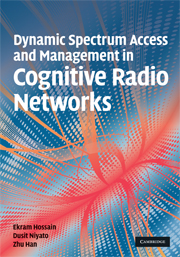Book contents
- Frontmatter
- Contents
- Preface
- Part I Introduction
- Part II Techniques for design, analysis, and optimization of dynamic spectrum access and management
- 3 Signal processing techniques
- 4 Optimization techniques
- 5 Game theory
- 6 Intelligent algorithms
- Part III Dynamic spectrum access and management
- References
- Index
4 - Optimization techniques
from Part II - Techniques for design, analysis, and optimization of dynamic spectrum access and management
Published online by Cambridge University Press: 26 February 2010
- Frontmatter
- Contents
- Preface
- Part I Introduction
- Part II Techniques for design, analysis, and optimization of dynamic spectrum access and management
- 3 Signal processing techniques
- 4 Optimization techniques
- 5 Game theory
- 6 Intelligent algorithms
- Part III Dynamic spectrum access and management
- References
- Index
Summary
In a wireless network (more specifically, in a cognitive wireless network), the available radio resources such as bandwidth are very limited. On the other hand, the demands for the wireless services are exponentially increasing. Not only are the number of users booming, but also more bandwidth is required for new services such as video telephony, TV on demand, wireless Internet, and wireless gaming. Finding a way to accommodate all these requirements has become an emergent research issue in wireless networking. Resource allocation and its optimization are general methods to improve network performance, but there are tradeoffs for resource usage. One of the major research goals is to present these tradeoffs so that better implementations can be put into practice.
This chapter will focus on how to formulate cognitive wireless networking problems as optimization problems from the perspective of resource allocation. Specifically, this chapter discusses what the resources, parameters, practical constraints, and optimized performances are across the different layers. In addition, it addresses how to perform resource allocation in multiuser scenarios under the presence of the primary users. The tradeoffs between the different optimization goals and different users interests are also investigated. The goal is to provide a new perspective of wireless networking and resource allocation problems from the optimization point of view.
This chapter is organized as follows: Section 4.1 discusses the basic formulation of the cognitive radio resource allocation as a constrained optimization problem. Section 4.2 studies linear programming and the simplex algorithm as its solution. Section 4.3 investigates how to define a convex optimization problem and some variations. Then the solutions are discussed.
Information
- Type
- Chapter
- Information
- Publisher: Cambridge University PressPrint publication year: 2009
